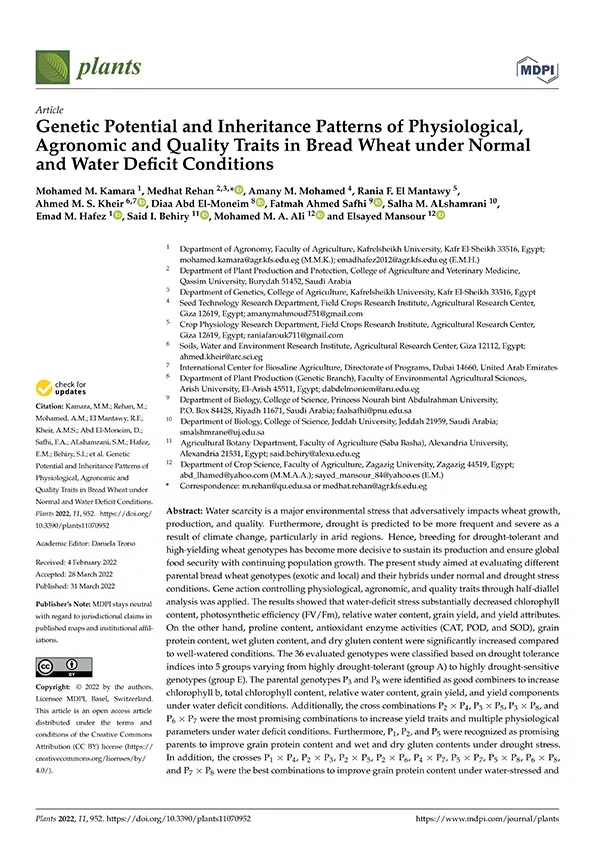Genetic Potential and Inheritance Patterns of Physiological, Agronomic and Quality Traits in Bread Wheat under Normal and Water Deficit Conditions
Water scarcity is a major environmental stress that adversatively impacts wheat growth, production, and quality. Furthermore, drought is predicted to be more frequent and severe as a result of climate change, particularly in arid regions. Hence, breeding for drought-tolerant and high-yielding wheat genotypes has become more decisive to sustain its production and ensure global food security with continuing population growth. The present study aimed at evaluating different parental bread wheat genotypes (exotic and local) and their hybrids under normal and drought stress conditions. Gene action controlling physiological, agronomic, and quality traits through half-diallel analysis was applied. The results showed that water-deficit stress substantially decreased chlorophyll content, photosynthetic efficiency (FV/Fm), relative water content, grain yield, and yield attributes. On the other hand, proline content, antioxidant enzyme activities (CAT, POD, and SOD), grain protein content, wet gluten content, and dry gluten content were significantly increased compared to well-watered conditions. The 36 evaluated genotypes were classified based on drought tolerance indices into 5 groups varying from highly drought-tolerant (group A) to highly drought-sensitive genotypes (group E). The parental genotypes P3 and P8 were identified as good combiners to increase chlorophyll b, total chlorophyll content, relative water content, grain yield, and yield components under water deficit conditions. Additionally, the cross combinations P2 x P4, P3 x P5, P3 x P8, and P6 x P7 were the most promising combinations to increase yield traits and multiple physiological parameters under water deficit conditions. Furthermore, P1, P2, and P5 were recognized as promising parents to improve grain protein content and wet and dry gluten contents under drought stress. In addition, the crosses P1 x P4, P2 x P3, P2 x P5, P2 x P6, P4 x P7, P5 x P7, P5 x P8, P6 x P8, and P7 x P8 were the best combinations to improve grain protein content under water-stressed and non-stressed conditions. Certain physiological traits displayed highly positive associations with grain yield and its contributing traits under drought stress such as chlorophyll a, chlorophyll b, total chlorophyll content, photosynthetic efficiency (Fv/Fm), proline content, and relative water content, which suggest their importance for indirect selection under water deficit conditions. Otherwise, grain protein content was negatively correlated with grain yield, indicating that selection for higher grain yield could reduce grain protein content under drought stress conditions.
